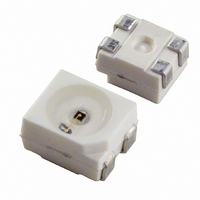LCW E6SG-V1AB-4R9T-Z OSRAM Opto Semiconductors Inc, LCW E6SG-V1AB-4R9T-Z Datasheet - Page 20

LCW E6SG-V1AB-4R9T-Z
Manufacturer Part Number
LCW E6SG-V1AB-4R9T-Z
Description
LED TOPLED WARM WHT 3000K 4-PLCC
Manufacturer
OSRAM Opto Semiconductors Inc
Series
TOPLEDr
Datasheet
1.LCW_E6SG-V2BA-4O9Q-Z.pdf
(22 pages)
Specifications of LCW E6SG-V1AB-4R9T-Z
Package / Case
4-PLCC
Viewing Angle
120°
Color
White
Luminous Flux @ Current - Test
3.94 lm
Millicandela Rating
1255mcd
Current - Test
30mA
Wavelength - Dominant
3000K
Voltage - Forward (vf) Typ
3.4V
Lens Type
Diffused, Yellow Tinted
Lens Style/size
Round, 2.4mm
Size / Dimension
3.20mm L x 2.80mm W
Height
2.10mm
Mounting Type
Surface Mount
Resistance Tolerance
3000K
Led Size
2.8 mm x 3.2 mm
Illumination Color
Warm White
Operating Voltage
3.4 V
Luminous Intensity
710 mcd to 1800 mcd
Mounting Style
SMD/SMT
Operating Current
30 mA
Color Temperature
3000 K
Lens Dimensions
2.4 mm
Lens Shape
Flat Round
Maximum Operating Temperature
+ 110 C
Minimum Operating Temperature
- 40 C
Lead Free Status / RoHS Status
Lead free / RoHS Compliant
Wavelength - Peak
-
Lead Free Status / Rohs Status
Lead free / RoHS Compliant
Other names
475-2608-2
Q65110A7737
Q65110A7737
Revision History: 2008-10-10
Previous Version: 2008-02-07
Patent List
Patent No.
US 6 066 861
US 6 277 301
US 6 245 259
US 6 576 930
Wegen der Streichung der LED aus der IEC 60825-1 (2nd edition 2007-03) erfolgt die Bewertung der Augesicherheit
nach dem Standard CIE S009/E:2002 ("photobiological safety of lamps and lamp systems") / IEC 62471 (1st edition
2006-07).
Im Risikogruppensystem dieser CIE- Norm erf¸llen die in diesem Datenblatt angegebenen LED die "moderate risk"-
Gruppe (die die sich im "sichtbaren" Spektralbereich auf eine Expositionsdauer von 0,25 s bezieht). Unter realen
Umst‰nden (f¸r Expositionsdauer, Augenpupille, Betrachtungsabstand) geht damit von diesen Bauelementen keinerlei
Augengef‰hrdung aus.
Grunds‰tzlich sollte jedoch erw‰hnt werden, dass intensive Lichtquellen durch ihre Blendwirkung ein hohes se-
kund‰res Gefahrenpotenzial besitzen. Wie nach dem Blick in andere helle Lichtquellen (z.B. Autoscheinwerfer) auch,
kˆnnen tempor‰r eingeschr‰nktes Sehvermˆgen und Nachbilder je nach Situation zu Irritationen, Bel‰stigungen, Be-
eintr‰chtigungen oder sogar Unf‰llen f¸hren.
Due to the cancellation of the LED from IEC 608251 (2nd edition 2007-03) , the evaluation of eye safety occurs accor-
ding to the dual IEC/CIE logo standard CIE S009/E:2002 ("photobiological safety of lamps and lamp systems")-
IEC 62471 (1st edition 2006-07).
Within the risk grouping system of this CIE standard, the LEDs specified in this data sheet fall into the "lmoderate risk"
group (relating to devices in the visible spectrum with an exposure time of 0.25s). Under real circumstances (for expo-
sure time, eye pupils, observation distance), it is assumed that no endangerment to the eye exists from these devices.
As a matter of principle, however, it should be mentioned that intense light sources have a high secondary exposure
potential due to their blinding effect. As is also true when viewing other bright light sources (e.g. headlights), temporary
reduction in visual acuity and afterimages can occur, leading to irritation, annoyance, visual impairment, and even
accidents, depending on the situation
2008-10-10
Page
1, 14
10
3
11
all
1, 15
Subjects (major changes since last revision)
Jedec Level changed acc. to OS-IN-2006-029
OS-IN-2007-021
Junction temperature >150 °C for short term applications added
Target median Lifetime for Tj 150°C added
OS-PCN-2008-003-A
taping updated
20
Date of change
2006-10-16
2007-10-19
2007-12-13
2007-12-13
2008-02-01
2008-02-07
LCW E6SG


















